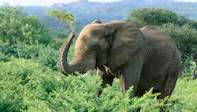

Audrey is monitoring elephant behaviour and feeding habits in the park, but is also doing some dung analysis. She is collecting dung to look at the ratio of leaves (from trees and shrubs) to grasses in the dung, giving an idea of what the elephants have been eating. She is also collecting dung samples to be tested for stress hormones.
However, collecting elephant dung is not as simple as it sounds, as Audrey can only collect dung if she knows the age and sex of the elephant that produced it. Although she is allowed to get out of her vehicle to collect the dung, she may not do so in front of tourists, but just recently she says that the tourists have had perfect timing and keep appearing and catching her scratching around in the dung balls.
The elephant research is focussed in two areas - the Skukuza/Lower Sabie/Pretoriuskop area and the Satara region. A total of 12 elephants have been collared in the two areas, but Audrey is also observing the behaviour of any elephants that she sees.
"Elephant feeding time is on average one or two minutes [on a particular bush] because of the number of vehicles." She reports that the feeding behaviour depends a lot on traffic, and that every time a car comes speeding by the elephants give a head shake and move off back into the bushes or move on to another tree.In comparison, she has seen elephants on Makalali spend up to 15 minutes having a good snack in one spot. Audrey will soon be moving her elephant watching and dung collecting to the Satara region, so if visitors to Kruger spot an outsize dung beetle with only two legs scratching around in the elephant droppings, check for the nearby vehicle displaying the Sanparks kudu head emblem, and know that the pooper-scooping is going on in the name of science and the big elephant debate.
What the elephant research project entails

Audrey started with her elephant monitoring and dung collecting in March. Every time she sees an elephant in her study area, she will have to record its exact location, the surrounding habitat and the age and sex of other elephants in the group. She will be compiling elephant photo identikits and each elephant monitored will have its identity checked and recorded along with the general behaviour of the group.
Some elephants in the group will be continuously observed. Audrey will have to record the distance the elephant moves, the reason for moving, feeding behaviour (tree species, type of browse (bark, leaf etc), bite size, interval between bites, proportion of tree taken per bite, proportion of tree eaten before moving on.
Observations will also be made for 15 minutes at a time, where feeding, moving, social, resting and other behaviours will be recorded every minute.
By knowing individuals in a group and seeing how the animals relate to each other, Audrey will be able to see how many calves associate with a particular female elephant. By assessing the age of the calves, the time between their births can be estimated. This calving interval can be used to determine population growth rates.Audrey will ship some dung to America to be analysed for stress hormones. She will also estimate the ratio of woody plants to grasses in the dung to see if the elephants have been browsing or grazing. Stress hormone analysis will be linked to how the female groups relate to each other, and environmental conditions like drought.

 While everyone agrees that elephants eat both grasses and leafy material from shrubs and trees, some debate has been ongoing in scientific c...
While everyone agrees that elephants eat both grasses and leafy material from shrubs and trees, some debate has been ongoing in scientific c...